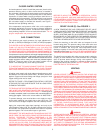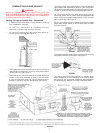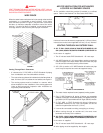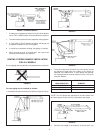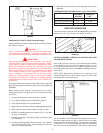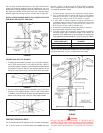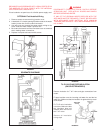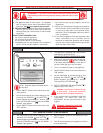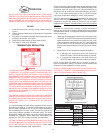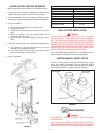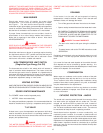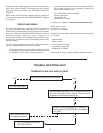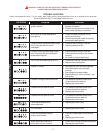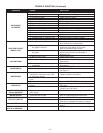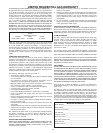
15
USERS OF THIS APPLIANCE SHOULD BE AWARE THAT GAS
COMPONENTS WEAR OUT OVER A PERIOD OF TIME. THE
GAS CARRYING COMPONENTS OF THIS APPLIANCE SHOULD
BE INSPECTED FOR PROPER OPERATION PERIODICALLY BY
A QUALIFIED SERVICE TECHNICIAN.
MAIN BURNER
Check main burner every 12 months for proper flame
characteristics. This is done by removing door(s) on heater,
see Figure 1. The main burner should provide complete
combustion of gas; ignite rapidly; give reasonably quiet operation;
cause no excessive flame lifting from burner ports. Make sure
that the flow of combustion and ventilation air is not blocked.
If proper flame characteristics are not evident, check for
accumulation of lint or other foreign material that restricts or
blocks the air openings in the heater or burner. Also check
AIR REQUIREMENTS.
WARNING
SOOT BUILD-UP INDICATES A PROBLEM THAT REQUIRES
CORRECTION BEFORE FURTHER USE. CONSULT WITH A
QUALIFIED SERVICE TECHNICIAN.
Should the main burner or burner air openings require cleaning,
turn the blower switch to “OFF” position and allow the burner to
cool. Remove the burner and clean with a soft brush. Clean
main burner orifice with a suitable soft material.
HIGH TEMPERATURE LIMIT SWITCH
(Single-Use Type Energy Cut Off)
The thermostat has a built-in limit switch which will actuate in
case of excessive water temperatures. The heater cannot be
relit until the gas control valve is replaced. It is important that a
serviceman be called to determine the reason for limit operation
and thus avoid repeated thermostat replacement. Lower the
temperature adjustment setting on new control.
VENTING SYSTEM
HAVE VENTING SYSTEM CHECKED EVERY SIX MONTHS FOR
OBSTRUCTIONS AND/OR DETERIORATION IN VENT PIPING.
POWER VENTER MAINTENANCE
The “POWER” venter must be inspected yearly.
1. MOTOR - Motor must rotate freely.
For safety and satisfactory operation it is recommended that the
heater be checked once a year by a competent service person.
T & P VALVE
At least once a year, the temperature and pressure relief valve
must be checked to ensure that it is in operating condition. Lift
the lever at the top of the valve several times until the valve seats
properly and operates freely.
DANGER
THE WATER PASSING OUT OF THE VALVE DURING THIS
CHECKING OPERATION MAY BE EXTREMELY HOT. AVOID
CONTACT AND DISCHARGE SAFELY TO PREVENT WATER
DAMAGE.
DRAINING
If the heater is to be shut off and exposed to freezing
temperatures, it must be drained. Water, if left in the tank and
allowed to freeze, will damage the heater.
• Turn off the gas and cold water inlet valve to the heater.
• Open a nearby hot water faucet and the heater drain valve.
• BE CAREFUL TO GRASP THE DRAIN VALVE HANDLE
SO THAT THE HAND IS NOT EXPOSED TO HOT WATER.
IF DESIRED, A HOSE MAY BE CONNECTED TO THE
DRAIN VALVE TO CARRY THE WATER AWAY.
DANGER: The water CAN BE HOT.
• The drain valve must be left open during the shutdown
period.
• To restart heater, refer to the FILLING instructions under
OPERATION.
Periodically open the drain valve and allow the water to run until
it flows clean. This will help prevent sediment build-up in the
tank.
It is normal for lime and scale deposits to form within the tank.
Such deposits will not be removed by periodic draining. It is
necessary to chemically delime the affected parts in water areas
where such deposits are encountered.
CONDENSATION
Water vapor can condense on the cooler surfaces of the tank
forming droplets, these drip into the fire or run out on the floor.
This is common at the time of startup after installation, during
periods of time when incoming water is very cold, or the heater
may be undersized for the requirements.
Droplets from the bottom of the flue may be due to corrosive
combustion products or improper vent. Check with your dealer
for more information.
CATHODIC PROTECTION - ANODE
The anode rod is used to protect the tank from corrosion. Most
hot water tanks are equipped with an anode rod. The sub-
merged rod sacrifices itself to protect the tank. Instead of
corroding the tank, water ions attack and eat away the anode
rod. This does not affect the water’s taste or color. The rod must
be maintained to keep the tank in operating condition.
Anode deterioration depends on water conductivity, not
necessarily water condition. A corroded or pitted anode rod
indicates high water conductivity and should be checked and/or
replaced more often than an anode rod that appears to be intact.
Replacement of a depleted anode rod can extend the life of your
water heater. Inspection should be conducted by a qualified
technician, and at a minimum should be checked annually after
the warranty period.



